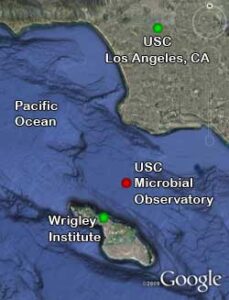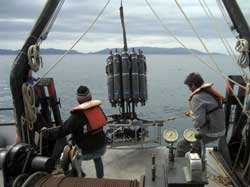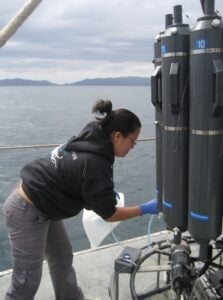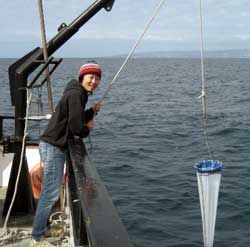 The USC Microbial Observatory is a collaborative research project established in 2000. Originally funded by the NSF through the Microbial Observatory initiative, it has also received support from the Dimension of Bidiversity program within the NSF, and is presently funded by NSF Biological Oceanography under the title “Pattern and Process in Marine Bacterial, Archaeal, and Protistan Biodiversity, and Effects of Human Impact”. The research focus of the observatory is an investigation of the microbial diversity and microbial community composition at a study site in the San Pedro Channel and Basin off the coast of southern California. The Channel area encompasses a diversity of coastal ocean habitats. The near-coast region borders one of the most highly urbanized areas of the country (greater Los Angeles) while open ocean waters impinge on the Channel Island archipelago that extends to within 30 km of the mainland. The San Pedro Basin is a deep-water environment (~890 m) that exhibits very low oxygen concentration (<1 ml L-1) at depths greater than 150 m. The overarching objective of this project is the derivation of fundamental understanding of how microbial communities in the ocean are organized spatially (with depth) and temporally (at scales from days to years), and how environmental and biological factors shape this organization.
The USC Microbial Observatory is a collaborative research project established in 2000. Originally funded by the NSF through the Microbial Observatory initiative, it has also received support from the Dimension of Bidiversity program within the NSF, and is presently funded by NSF Biological Oceanography under the title “Pattern and Process in Marine Bacterial, Archaeal, and Protistan Biodiversity, and Effects of Human Impact”. The research focus of the observatory is an investigation of the microbial diversity and microbial community composition at a study site in the San Pedro Channel and Basin off the coast of southern California. The Channel area encompasses a diversity of coastal ocean habitats. The near-coast region borders one of the most highly urbanized areas of the country (greater Los Angeles) while open ocean waters impinge on the Channel Island archipelago that extends to within 30 km of the mainland. The San Pedro Basin is a deep-water environment (~890 m) that exhibits very low oxygen concentration (<1 ml L-1) at depths greater than 150 m. The overarching objective of this project is the derivation of fundamental understanding of how microbial communities in the ocean are organized spatially (with depth) and temporally (at scales from days to years), and how environmental and biological factors shape this organization.
The basic premise of this project is that microbes exist in natural ecosystems as collections of interdependent groups of species. These groups constitute functional subunits within the huge diversity of taxa that comprise planktonic microbial communities. The microbial species forming these groups are functionally interdependent, and act as ‘ecological units’ that replace one and other in time and space as environmental conditions change.
 The component of this project conducted in the Caron lab focuses on the species diversity and abundances of microbial eukaryotes (primarily protists), their temporal and vertical distributions in the water column, and their trophic activities. Historically, species of protists have been identified based primarily on morphological characteristics (e.g. cell size and shape, the presence and arrangement of flagella or cilia). While characters of size, shape, etc. are still essential for scientists interested in taxonomy and evolution, the identification of protistan species based on their morphologies has been less useful to ecologists because microscopic methods tend to be tedious and expensive. Also, many species (e.g. protists less than 20 µm in size; <0.0008 inches) are exceedingly difficult to identify by light microscopy because they possess few distinctive features. For these reasons, a considerable effort within the lab has been, and continues to be, the development and application of genetic, ‘culture independent’ approaches for identifying and counting protists that do not rely on microscopy for documenting the diversity and abundance of protistan species in nature. Discovery of new species (based on the presence of novel DNA sequences) is a major thrust of this research program. Also, DNA sequences are being employed to develop techniques to assay the protistan assemblage composition rapidly and accurately. Traditional microscopy and culture is also being applied to provide morphological and physiological information on ecologically important species.
The component of this project conducted in the Caron lab focuses on the species diversity and abundances of microbial eukaryotes (primarily protists), their temporal and vertical distributions in the water column, and their trophic activities. Historically, species of protists have been identified based primarily on morphological characteristics (e.g. cell size and shape, the presence and arrangement of flagella or cilia). While characters of size, shape, etc. are still essential for scientists interested in taxonomy and evolution, the identification of protistan species based on their morphologies has been less useful to ecologists because microscopic methods tend to be tedious and expensive. Also, many species (e.g. protists less than 20 µm in size; <0.0008 inches) are exceedingly difficult to identify by light microscopy because they possess few distinctive features. For these reasons, a considerable effort within the lab has been, and continues to be, the development and application of genetic, ‘culture independent’ approaches for identifying and counting protists that do not rely on microscopy for documenting the diversity and abundance of protistan species in nature. Discovery of new species (based on the presence of novel DNA sequences) is a major thrust of this research program. Also, DNA sequences are being employed to develop techniques to assay the protistan assemblage composition rapidly and accurately. Traditional microscopy and culture is also being applied to provide morphological and physiological information on ecologically important species.
 The USC Microbial Observatory is unique in that it entails an assessment of the complete spectrum of microorganisms (from viruses to the largest protists) in the water column. Genetic fingerprinting of the totalmicrobial community is the primary tool for revealing the trophic roles and relationships among microbial taxa (predation, mutualism, commensalism, parasitism/infection), and to generate hypotheses on the interdependences among these species. Experimental studies involve manipulative food web experiments to test hypotheses concerning the relationships and interactions among the various microbial species. The data support extensive statistical analyses to identify relationships between microbial taxa, and with environmental parameters.
The USC Microbial Observatory is unique in that it entails an assessment of the complete spectrum of microorganisms (from viruses to the largest protists) in the water column. Genetic fingerprinting of the totalmicrobial community is the primary tool for revealing the trophic roles and relationships among microbial taxa (predation, mutualism, commensalism, parasitism/infection), and to generate hypotheses on the interdependences among these species. Experimental studies involve manipulative food web experiments to test hypotheses concerning the relationships and interactions among the various microbial species. The data support extensive statistical analyses to identify relationships between microbial taxa, and with environmental parameters.
 Monthly sampling at our site includes plankton and water samples collected at various depths and returned to the lab. Protists in these samples are concentrated on filters, their nucleic acids are extracted and used in a variety of genetic analyses to examine protistan biodiversity. Approaches currently being applied involve high-throughput sequencing of ribosomal RNA (rRNA) and ribosomal DNA (rDNA). In addition to our molecular characterization, this project also employs more traditional methods of light and electron microscopy, and flow cytometry to characterize the abundances of the microbial assemblages at our study site. We have cultured a diverse array of protists from the observatory site in order to augment our culture collection for laboratory-based studies of their physiology. For more information, data and publications resulting from this project, check out our USC Microbial Observatory webpage.
Monthly sampling at our site includes plankton and water samples collected at various depths and returned to the lab. Protists in these samples are concentrated on filters, their nucleic acids are extracted and used in a variety of genetic analyses to examine protistan biodiversity. Approaches currently being applied involve high-throughput sequencing of ribosomal RNA (rRNA) and ribosomal DNA (rDNA). In addition to our molecular characterization, this project also employs more traditional methods of light and electron microscopy, and flow cytometry to characterize the abundances of the microbial assemblages at our study site. We have cultured a diverse array of protists from the observatory site in order to augment our culture collection for laboratory-based studies of their physiology. For more information, data and publications resulting from this project, check out our USC Microbial Observatory webpage.
Our collaborators on this program are Dr. Jed Fuhrman of USC and the USC Wrigley Institute for Environmental Studies which maintains the San Pedro Ocean Time Series.